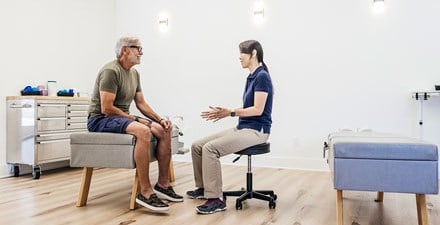
Carpal tunnel syndrome is caused by compression of the median nerve in the carpal tunnel of the wrist. The carpal tunnel is a small passageway formed by the wrist bones and ligaments. The tunnel protects the finger flexor tendons and the median nerves that pass through it.
Risk Factors
- Injury: Wrist fractures or dislocations may decrease the size of the tunnel.
- Gender: Females are more likely to get carpal tunnel, possibly from a smaller size of the tunnel.
- Alteration in body fluid: Water retention, common in menopause and pregnancy, may increase the pressure within the carpal tunnel, irritating the nerve.
- Workplace factors: Working with vibrating tools, on an assembly line, or with a computer for extended periods of time requires prolonged and repetitive flexion of the wrist, which may increase the pressure in the carpal tunnel, irritating the nerve.
Common Symptoms
- Numbness and tingling sensations on the palm of the hand
- Symptoms worsen at night
- Driving, typing, and holding items exacerbate symptoms
- Shaking out the hand relieves symptoms
- Hand weakness or clumsiness (ie, difficulty with grip, dropping keys)
Tips to Avoid Carpal Tunnel Syndrome
- Take frequent breaks when performing activities that require prolonged wrist flexion, such as typing.
- Avoid sleeping on your hands.
- Wear a night splint to keep your wrists in a neutral position while you sleep.
Treatment by a Physical Therapist
Conservative treatment by a physical therapist may involve:
- Night splint: Wearing a splint with the wrist in neutral to 15° of extension maintains the carpal tunnel in the most open position to decrease pressure on the nerve.
- Ergonomic education: Workstations should be altered in order to reduce repetitive postures and maintain the wrist, elbow, head, and neck in neutral positions.
- Tendon glides: Isolated tendon glides should be performed.
- Anti-inflammatories: Corticosteroids may be prescribed to decrease the inflammation.
If symptoms continue to be severe and persistent after trying conservative treatment options, a physical therapist may refer you to a surgeon to relieve pressure in the carpal tunnel by releasing the ligament over the tunnel. Physical therapist treatment is important after surgery to help restore strength to the wrist and teach you how to modify habits that led to the symptoms.
After surgery physical therapist treatment may include:
- Exercises to improve the strength of the wrist and hand muscles and improve function
- Stretching to improve mobility of the wrist and fingers and improve function
- Scar management to keep the skin supple and flexible
- Education regarding appropriate posture and wrist position to avoid carpal tunnel compression in home and leisure activities
- A work site visit or simulation to optimize postures and positions
Physical therapists are movement experts. They improve quality of life through hands-on care, patient education, and prescribed movement. You can contact a physical therapist directly for an evaluation. To find a physical therapist in your area, visit Find a PT.
Learn more about how physical therapists treat carpal tunnel syndrome.


